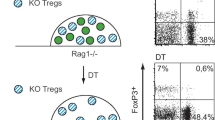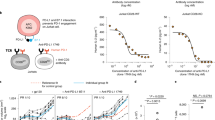Abstract
CD4+CD25+ regulatory T cells have been characterized as a critical population of immunosuppressive cells. They play a crucial role in cancer progression by inhibiting the effector function of CD4+ or CD8+ T lymphocytes. However, whether regulatory T lymphocytes that expand during tumor progression can modulate dendritic cell function is unclear. To address this issue, we have evaluated the inhibitory potential of CD4+CD25+ regulatory T cells from mice bearing a BCR–ABL+ leukemia on bone marrow-derived dendritic cells. We present data demonstrating that CD4+CD25+FoxP3+ regulatory T cells from tumor-bearing animals impede dendritic cell function by down-regulating the activation of the transcription factor NF-κB. The expression of the co-stimulatory molecules CD80, CD86 and CD40, the production of TNF-α, IL-12, and CCL5/RANTES by the suppressed DC is strongly down-regulated. The suppression mechanism requires TGF-β and IL-10 and is associated with induction of the Smad signaling pathway and activation of the STAT3 transcription factor.







Similar content being viewed by others
References
Sakaguchi S (2005) Naturally arising Foxp3-expressing CD25(+)CD4(+) regulatory T cells in immunological tolerance to self and non-self. Nat Immunol 6:345–352
Shevach EM (2002) CD4+ CD25+ suppressor T cells: more questions than answers. Nat Rev Immunol 2:389–400
Asano M, Toda M, Sakaguchi N et al (1996) Autoimmune disease as a consequence of developmental abnormality of a T cell subpopulation. J Exp Med 184:387–396
Sakaguchi S, Sakaguchi N, Asano M et al (1995) Immunologic self-tolerance maintained by activated T cells expressing IL-2 receptor alpha-chains (CD25). Breakdown of a single mechanism of self-tolerance causes various autoimmune diseases. J Immunol 155:1151–1164
Belkaid Y, Piccirillo CA, Mendez S et al (2002) CD4+CD25+ regulatory T cells control Leishmania major persistence and immunity. Nature 420:502–507
Cobbold SP, Nolan KF, Graca L et al (2003) Regulatory T cells and dendritic cells in transplantation tolerance: molecular markers and mechanisms. Immunol Rev 196:109–124
Shimizu J, Yamazaki S, Sakaguchi S (1999) Induction of tumor immunity by removing CD25+CD4+ T cells: a common basis between tumor immunity and autoimmunity. J Immunol 163:5211–5218
Sakaguchi S (2000) Regulatory T cells: key controllers of immunologic self-tolerance. Cell 101:455–458
Antony PA, Piccirillo CA, Akpinarli A et al (2005) CD8+ T cell immunity against a tumor/self-antigen is augmented by CD4+ T helper cells and hindered by naturally occurring T regulatory cells. J Immunol 174:2591–2601
Woo EY, Yeh H, Chu CS et al (2002) Cutting edge: regulatory T cells from lung cancer patients directly inhibit autologous T cell proliferation. J Immunol 168:4272–4276
Liyanage UK, Moore TT, Joo HG et al (2002) Prevalence of regulatory T cells is increased in peripheral blood and tumor microenvironment of patients with pancreas or breast adenocarcinoma. J Immunol 169:2756–2761
Ormandy LA, Hillemann T, Wedemeyer H et al (2005) Increased populations of regulatory T cells in peripheral blood of patients with hepatocellular carcinoma. Cancer Res 65:2457–2464
Liu JY, Zhang XS, Ding Y et al (2005) The changes of CD4+CD25+/CD4+ proportion in spleen of tumor-bearing BALB/c mice. J Transl Med 3:5
Ghiringhelli F, Larmonier N, Schmitt E et al (2004) CD4+CD25+ regulatory T cells suppress tumor immunity but are sensitive to cyclophosphamide which allows immunotherapy of established tumors to be curative. Eur J Immunol 34:336–344
Sutmuller RP, van Duivenvoorde LM, van Elsas A et al (2001) Synergism of cytotoxic T lymphocyte-associated antigen 4 blockade and depletion of CD25(+) regulatory T cells in antitumor therapy reveals alternative pathways for suppression of autoreactive cytotoxic T lymphocyte responses. J Exp Med 194:823–832
Yu P, Lee Y, Liu W et al (2005) Intratumor depletion of CD4+ cells unmasks tumor immunogenicity leading to the rejection of late-stage tumors. J Exp Med 201:779–791
Prasad SJ, Farrand KJ, Matthews SA et al (2005) Dendritic cells loaded with stressed tumor cells elicit long-lasting protective tumor immunity in mice depleted of CD4+CD25+ regulatory T cells. J Immunol 174:90–98
Fontenot JD, Rudensky AY (2005) A well adapted regulatory contrivance: regulatory T cell development and the forkhead family transcription factor Foxp3. Nat Immunol 6:331–337
Fontenot JD, Gavin MA, Rudensky AY (2003) Foxp3 programs the development and function of CD4+CD25+ regulatory T cells. Nat Immunol 4:330–336
Hori S, Nomura T, Sakaguchi S (2003) Control of regulatory T cell development by the transcription factor Foxp3. Science 299:1057–1061
Fontenot JD, Rasmussen JP, Williams LM et al (2005) Regulatory T cell lineage specification by the forkhead transcription factor foxp3. Immunity 22:329–341
Nakamura K, Kitani A, Fuss I et al (2004) TGF-beta 1 plays an important role in the mechanism of CD4+CD25+ regulatory T cell activity in both humans and mice. J Immunol 172:834–842
Nakamura K, Kitani A, Strober W (2001) Cell contact-dependent immunosuppression by CD4(+)CD25(+) regulatory T cells is mediated by cell surface-bound transforming growth factor beta. J Exp Med 194:629–644
Piccirillo CA, Letterio JJ, Thornton AM et al (2002) CD4(+)CD25(+) regulatory T cells can mediate suppressor function in the absence of transforming growth factor beta1 production and responsiveness. J Exp Med 196:237–246
Misra N, Bayry J, Lacroix-Desmazes S et al (2004) Cutting edge: human CD4+CD25+ T cells restrain the maturation and antigen-presenting function of dendritic cells. J Immunol 172:4676–4680
Sato K, Tateishi S, Kubo K et al (2005) Downregulation of IL-12 and a novel negative feedback system mediated by CD25(+)CD4(+) T cells. Biochem Biophys Res Commun 330:226–232
Cederbom L, Hall H, Ivars F (2000) CD4+CD25+ regulatory T cells down-regulate co-stimulatory molecules on antigen-presenting cells. Eur J Immunol 30:1538–1543
Serra P, Amrani A, Yamanouchi J et al (2003) CD40 ligation releases immature dendritic cells from the control of regulatory CD4+CD25+ T cells. Immunity 19:877–889
Chen W, Qin H, Reese VA et al (1998) CTLs specific for bcr–abl joining region segment peptides fail to lyse leukemia cells expressing p210 bcr–abl protein. J Immunother 21:257–268
McLaughlin J, Chianese E, Witte ON (1987) In vitro transformation of immature hematopoietic cells by the P210 BCR/ABL oncogene product of the Philadelphia chromosome. Proc Natl Acad Sci USA 84:6558–6562
He L, Feng H, Raymond A et al (2001) Dendritic-cell-peptide immunization provides immunoprotection against bcr–abl-positive leukemia in mice. Cancer Immunol Immunother 50:31–40
Feng H, Zeng Y, Whitesell L et al (2001) Stressed apoptotic tumor cells express heat shock proteins and elicit tumor-specific immunity. Blood 97:3505–3512
Nishikawa H, Jager E, Ritter G et al (2005) CD4+ CD25+ regulatory T cells control the induction of antigen-specific CD4+ helper T cell responses in cancer patients. Blood 106:1008–1011
Somasundaram R, Jacob L, Swoboda R et al (2002) Inhibition of cytolytic T lymphocyte proliferation by autologous CD4+/CD25+ regulatory T cells in a colorectal carcinoma patient is mediated by transforming growth factor-beta. Cancer Res 62:5267–5272
Onishi H, Kuroki H, Matsumoto K et al (2004) Monocyte-derived dendritic cells that capture dead tumor cells secrete IL-12 and TNF-alpha through IL-12/TNF-alpha/NF-kappaB autocrine loop. Cancer Immunol Immunother 53:1093–1100
Sakaguchi S (2004) Naturally arising CD4+ regulatory t cells for immunologic self-tolerance and negative control of immune responses. Annu Rev Immunol 22:531–562
Thornton AM, Shevach EM (1998) CD4+CD25+ immunoregulatory T cells suppress polyclonal T cell activation in vitro by inhibiting interleukin 2 production. J Exp Med 188:287–296
Chen W, Wahl SM (2003) TGF-beta: the missing link in CD4+CD25+ regulatory T cell-mediated immunosuppression. Cytokine Growth Factor Rev 14:85–89
Moore KW, de Waal Malefyt R, Coffman RL et al (2001) Interleukin-10 and the interleukin-10 receptor. Annu Rev Immunol 19:683–765
Williams LM, Ricchetti G, Sarma U et al (2004) Interleukin-10 suppression of myeloid cell activation—a continuing puzzle. Immunology 113:281–292
Hoentjen F, Sartor RB, Ozaki M et al (2005) STAT3 regulates NF-kappaB recruitment to the IL-12p40 promoter in dendritic cells. Blood 105:689–696
Taams LS, van Amelsfort JM, Tiemessen MM et al (2005) Modulation of monocyte/macrophage function by human CD4+CD25+ regulatory T cells. Hum Immunol 66:222–230
Almand B, Clark JI, Nikitina E et al (2001) Increased production of immature myeloid cells in cancer patients: a mechanism of immunosuppression in cancer. J Immunol 166:678–689
Almand B, Resser JR, Lindman B et al (2000) Clinical significance of defective dendritic cell differentiation in cancer. Clin Cancer Res 6:1755–1766
Chaux P, Favre N, Martin M et al (1997) Tumor-infiltrating dendritic cells are defective in their antigen-presenting function and inducible B7 expression in rats. Int J Cancer 72:619–624
Gabrilovich D (2004) Mechanisms and functional significance of tumour-induced dendritic-cell defects. Nat Rev Immunol 4:941–952
Monti P, Leone BE, Zerbi A et al (2004) Tumor-derived MUC1 mucins interact with differentiating monocytes and induce IL-10 high IL-12 low regulatory dendritic cell. J Immunol 172:7341–7349
Steinbrink K, Jonuleit H, Muller G et al (1999) Interleukin-10-treated human dendritic cells induce a melanoma-antigen-specific anergy in CD8(+) T cells resulting in a failure to lyse tumor cells. Blood 93:1634–1642
Kuwana M (2002) Induction of anergic and regulatory T cells by plasmacytoid dendritic cells and other dendritic cell subsets. Hum Immunol 63:1156–1163
Verginis P, Li HS, Carayanniotis G (2005) Tolerogenic semimature dendritic cells suppress experimental autoimmune thyroiditis by activation of thyroglobulin-specific CD4+CD25+ T Cells. J Immunol 174:7433–7439
Mahnke K, Qian Y, Knop J et al (2003) Induction of CD4+/CD25+ regulatory T cells by targeting of antigens to immature dendritic cells. Blood 101:4862–4869
Acknowledgments
The authors wish to thank Pawel Kiela for his helpful comments and Jennifer Uno for her help with real-time PCR. This work was supported in part by the NIH grant R01 CA104926 and the Tee Up for Tots Fund.
Author information
Authors and Affiliations
Corresponding author
Rights and permissions
About this article
Cite this article
Larmonier, N., Marron, M., Zeng, Y. et al. Tumor-derived CD4+CD25+ regulatory T cell suppression of dendritic cell function involves TGF-β and IL-10. Cancer Immunol Immunother 56, 48–59 (2007). https://doi.org/10.1007/s00262-006-0160-8
Received:
Accepted:
Published:
Issue Date:
DOI: https://doi.org/10.1007/s00262-006-0160-8




